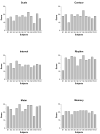Music perception by cochlear implant and normal hearing listeners as measured by the Montreal Battery for Evaluation of Amusia
- PMID: 18469714
- PMCID: PMC2676841
- DOI: 10.1097/AUD.0b013e318174e787
Music perception by cochlear implant and normal hearing listeners as measured by the Montreal Battery for Evaluation of Amusia
Abstract
Objectives: The purpose of this study was to explore the utility/possibility of using the Montreal Battery for Evaluation of Amusia (MBEA) test (Peretz, et al., Ann N Y Acad Sci, 999, 58-75) to assess the music perception abilities of cochlear implant (CI) users.
Design: The MBEA was used to measure six different aspects of music perception (Scale, Contour, Interval, Rhythm, Meter, and Melody Memory) by CI users and normal-hearing (NH) listeners presented with stimuli processed via CI simulations. The spectral resolution (number of channels) was varied in the CI simulations to determine: (a) the number of channels (4, 6, 8, 12, and 16) needed to achieve the highest levels of music perception and (b) the number of channels needed to produce levels of music perception performance comparable with that of CI users.
Results: CI users and NH listeners performed higher on temporal-based tests (Rhythm and Meter) than on pitch-based tests (Scale, Contour, and Interval)--a finding that is consistent with previous research studies. The CI users' scores on pitch-based tests were near chance. The CI users' (but not NH listeners') scores for the Memory test, a test that incorporates an integration of both temporal-based and pitch-based aspects of music, were significantly higher than the scores obtained for the pitch-based Scale test and significantly lower than the temporal-based Rhythm and Meter tests. The data from NH listeners indicated that 16 channels of stimulation did not provide the highest music perception scores and performance was as good as that obtained with 12 channels. This outcome is consistent with other studies showing that NH listeners listening to vocoded speech are not able to use effectively F0 cues present in the envelopes, even when the stimuli are processed with a large number (16) of channels. The CI user data seem to most closely match with the 4- and 6-channel NH listener conditions for the pitch-based tasks.
Conclusions: Consistent with previous studies, both CI users and NH listeners showed the typical pattern of music perception in which scores are higher on tests measuring the perception of temporal aspects of music (Rhythm and Meter) than spectral (pitch) aspects of music (Scale, Contour, and Interval). On that regard, the pattern of results from this study indicates that the MBEA is a suitable test for measuring various aspects of music perception by CI users.
Figures



Similar articles
-
Music perception and appraisal: cochlear implant users and simulated cochlear implant listening.J Am Acad Audiol. 2012 May;23(5):350-65; quiz 379. doi: 10.3766/jaaa.23.5.6. J Am Acad Audiol. 2012. PMID: 22533978 Free PMC article.
-
Evaluation of a Test Battery to Assess Perception of Music in Children With Cochlear Implants.JAMA Otolaryngol Head Neck Surg. 2014 Jun;140(6):540-7. doi: 10.1001/jamaoto.2014.341. JAMA Otolaryngol Head Neck Surg. 2014. PMID: 24722833
-
Comparison of bimodal and bilateral cochlear implant users on speech recognition with competing talker, music perception, affective prosody discrimination, and talker identification.Ear Hear. 2011 Feb;32(1):16-30. doi: 10.1097/AUD.0b013e3181edfbd2. Ear Hear. 2011. PMID: 21178567 Free PMC article.
-
Music perception with cochlear implants: a review.Trends Amplif. 2004;8(2):49-82. doi: 10.1177/108471380400800203. Trends Amplif. 2004. PMID: 15497033 Free PMC article. Review.
-
Music enjoyment with cochlear implantation.Auris Nasus Larynx. 2018 Oct;45(5):895-902. doi: 10.1016/j.anl.2017.11.008. Auris Nasus Larynx. 2018. PMID: 29519690 Review.
Cited by
-
Musical Emotion Categorization with Vocoders of Varying Temporal and Spectral Content.Trends Hear. 2023 Jan-Dec;27:23312165221141142. doi: 10.1177/23312165221141142. Trends Hear. 2023. PMID: 36628512 Free PMC article.
-
Preservation of rhythmic clocking in cochlear implant users: a study of isochronous versus anisochronous beat detection.Trends Amplif. 2010 Sep;14(3):164-9. doi: 10.1177/1084713810387937. Trends Amplif. 2010. PMID: 21109551 Free PMC article.
-
Residual neural processing of musical sound features in adult cochlear implant users.Front Hum Neurosci. 2014 Apr 3;8:181. doi: 10.3389/fnhum.2014.00181. eCollection 2014. Front Hum Neurosci. 2014. PMID: 24772074 Free PMC article.
-
Compensatory plasticity in the deaf brain: effects on perception of music.Brain Sci. 2014 Oct 28;4(4):560-74. doi: 10.3390/brainsci4040560. Brain Sci. 2014. PMID: 25354235 Free PMC article. Review.
-
Experience Changes How Emotion in Music Is Judged: Evidence from Children Listening with Bilateral Cochlear Implants, Bimodal Devices, and Normal Hearing.PLoS One. 2015 Aug 28;10(8):e0136685. doi: 10.1371/journal.pone.0136685. eCollection 2015. PLoS One. 2015. PMID: 26317976 Free PMC article.
References
-
- Bassim M, Buss E, Clark M, Kolln K, Pillsbury C, Pillsbury H, Buchman C. MED-EL Combi40+ cochlear implantation in adults. Laryngoscope. 2005;115(9):1568–1573. - PubMed
-
- Causey G, Hood L, Hermanson C, Bowling L. The Maryland CNC test: normative studies. Audiology. 1984;23(6):552–568. - PubMed
-
- Fujita S, Ito J. Ability of nucleus cochlear implantees to recognize music. The Annals of Otology, Rhinology, and Laryngology. 1999;108(7 Pt 1):634–640. - PubMed
-
- Gfeller K, Knutson J, Woodworth G, Witt S, DeBus B. Timbral recognition and appraisal by adult cochlear implant users and normal-hearing adults. Journal of the American Academy of Audiology. 1998;9(1):1–19. - PubMed
Reference notes
-
- Fearn R. Unpublished doctoral dissertation. University of New South Wales; Australia: 2001. Music and Pitch Perception of Cochlear Implant Recipients.
Publication types
MeSH terms
Grants and funding
LinkOut - more resources
Full Text Sources
Medical

